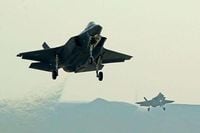In a dramatic escalation of hostilities between Iran and Israel, Iranian air defenses successfully shot down an Israeli F-35 fighter jet over the city of Tabriz in northwestern Iran on June 17, 2025. This marks the fourth such Israeli stealth aircraft to be intercepted and destroyed by Iranian forces amid a surge of military confrontations that began earlier in the month.
Majid Farshi, Director General of East Azerbaijan Crisis Management, confirmed to the Islamic Republic News Agency (IRNA) that two combat drones had also been downed in the Tabriz area prior to the fighter jet’s interception. He detailed that three locations around Tabriz were targeted on the same day, with Iranian air defense systems engaging Israeli invading micro air vehicles (MAVs), reflecting a broad and coordinated defensive effort by Iranian forces.
This latest downing of an F-35 comes just days after a series of unprecedented Israeli airstrikes inside Iranian territory on the night of June 13, 2025. These strikes targeted not only military installations but also residential buildings, resulting in civilian casualties and widespread damage to population centers. The attacks represented an unprovoked act of aggression, according to Iranian sources, and notably included targeted assassinations of high-ranking Iranian military officials.
Among those killed in the Israeli strikes were Major General Mohammad Baqeri, Chairman of the Chiefs of Staff of Iran’s Armed Forces, and Major General Hossein Salami, Commander-in-Chief of the Islamic Revolutionary Guard Corps (IRGC). Additional senior figures such as Gholamali Rashid, Commander of Khatam al-Anbiya Central Headquarters, and Amir Ali Hajizadeh, Commander of the IRGC Aerospace Force, were also reported dead. The strikes further claimed the lives of nine nuclear scientists and several other high-ranking officials, underscoring the depth and precision of the Israeli operation.
Following the initial Israeli attack, Iran launched a massive retaliatory strike the same evening, firing more than 150 ballistic missiles and deploying over 100 drones targeting Tel Aviv and other Israeli locations. These counterattacks caused significant civilian casualties and extensive damage, marking a dangerous intensification of the conflict between the two nations.
Details have emerged that the Israeli F-35 pilot was detained in a mountainous region within Iran, adding a human dimension to the military confrontation. The capture of such a high-value asset and personnel is likely to further complicate an already volatile situation.
Reports from Iranian military sources, including the Tasnim news agency affiliated with the IRGC, emphasize that this is the fourth Israeli F-35 fighter jet to be downed since the latest escalation began. The repeated losses of these advanced stealth aircraft highlight the increasing effectiveness of Iran’s air defense capabilities, particularly in contested airspace near its borders.
Despite the gravity of these developments, as of June 17, 2025, there has been no official comment from Tel Aviv regarding the downing of the F-35 or the detention of its pilot. This silence adds an element of uncertainty to the unfolding crisis, as both nations remain locked in a tit-for-tat exchange of attacks and counterattacks.
The attacks on June 13 not only targeted military leaders but also inflicted damage on residential areas, resulting in civilian deaths and injuries. This has raised international concerns about the humanitarian impact of the conflict, with whole population centers affected by the strikes. The targeting of non-combatants has drawn criticism and heightened tensions within the region and beyond.
Iran’s military response, involving a large salvo of ballistic missiles and drone strikes, demonstrates the country’s capacity and willingness to retaliate decisively against perceived aggression. The scale and intensity of these counterattacks suggest that the conflict could escalate further if diplomatic efforts fail to de-escalate tensions.
The downing of the Israeli F-35 and the detention of its pilot represent a significant symbolic and strategic victory for Iran. It underscores not only the risks inherent in Israel’s air operations over Iranian territory but also the resilience and sophistication of Iran’s air defense network. Majid Farshi’s statement to IRNA highlighted the ongoing vigilance of Iranian forces in protecting their airspace against a variety of aerial threats, including drones and micro air vehicles.
These events come amid a backdrop of long-standing hostility between Iran and Israel, with both countries viewing each other as existential threats. The recent spate of targeted killings, airstrikes, and retaliatory missile launches marks one of the most intense periods of conflict between the two nations in recent years.
As the situation remains fluid, the international community watches closely, concerned about the potential for wider regional instability. The deaths of high-ranking military officials and the involvement of sophisticated weaponry on both sides raise the stakes considerably. The possibility of further escalation looms large, with diplomatic channels yet to yield any significant breakthroughs.
In the meantime, the residents of Tabriz and other affected areas continue to face the harsh realities of modern warfare, caught between military confrontations that bring both destruction and uncertainty. The human cost of this conflict, particularly among civilians, remains a pressing concern amid the strategic and tactical developments unfolding on the ground and in the skies above.
With no official response from Israel and Iran’s firm stance on defending its territory, the prospects for immediate de-escalation appear slim. The downing of the F-35 fighter jet, alongside the broader campaign of strikes and counterstrikes, signals a dangerous new chapter in the Iran-Israel conflict, one that could have far-reaching consequences for regional security and international relations.


